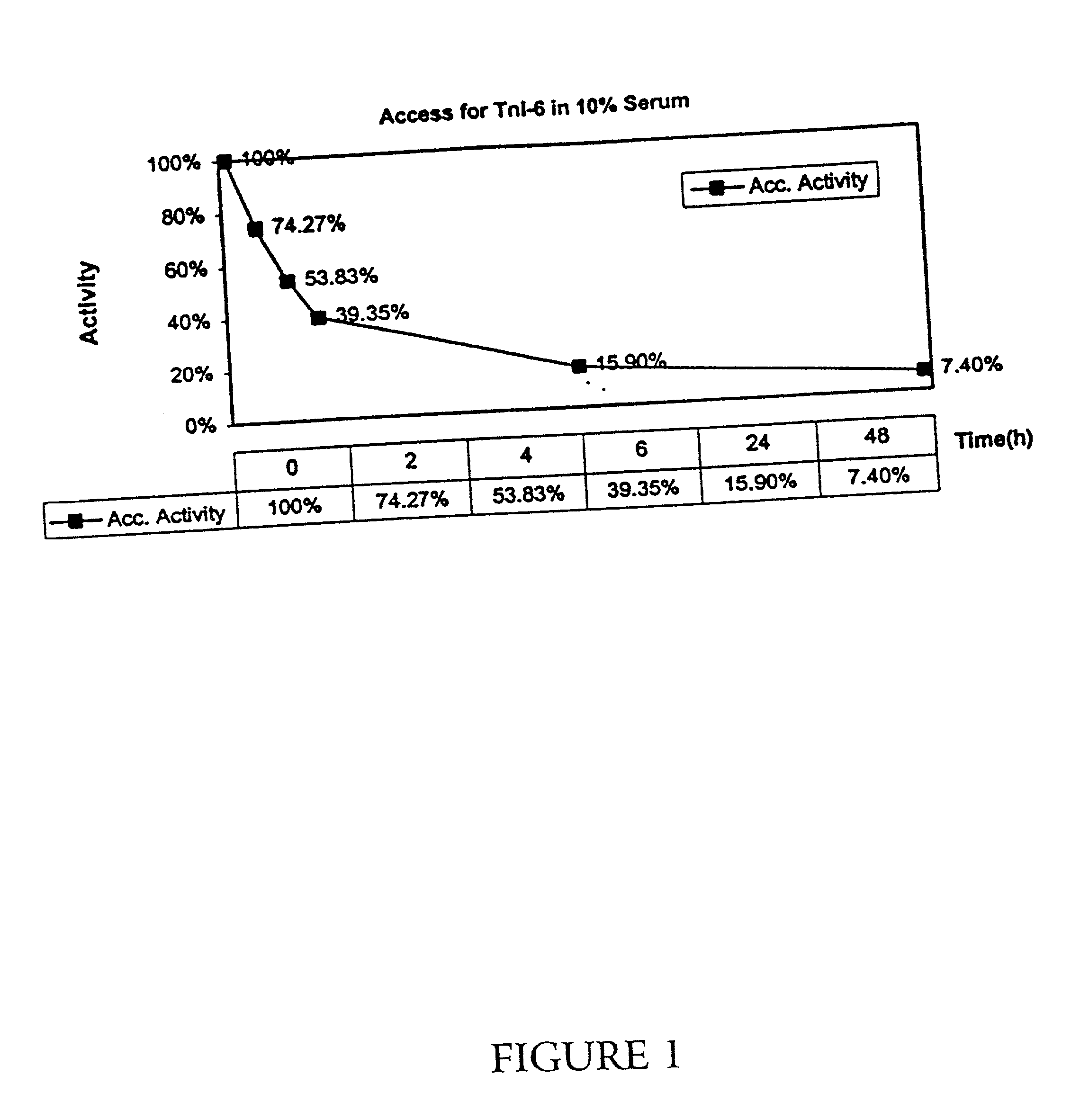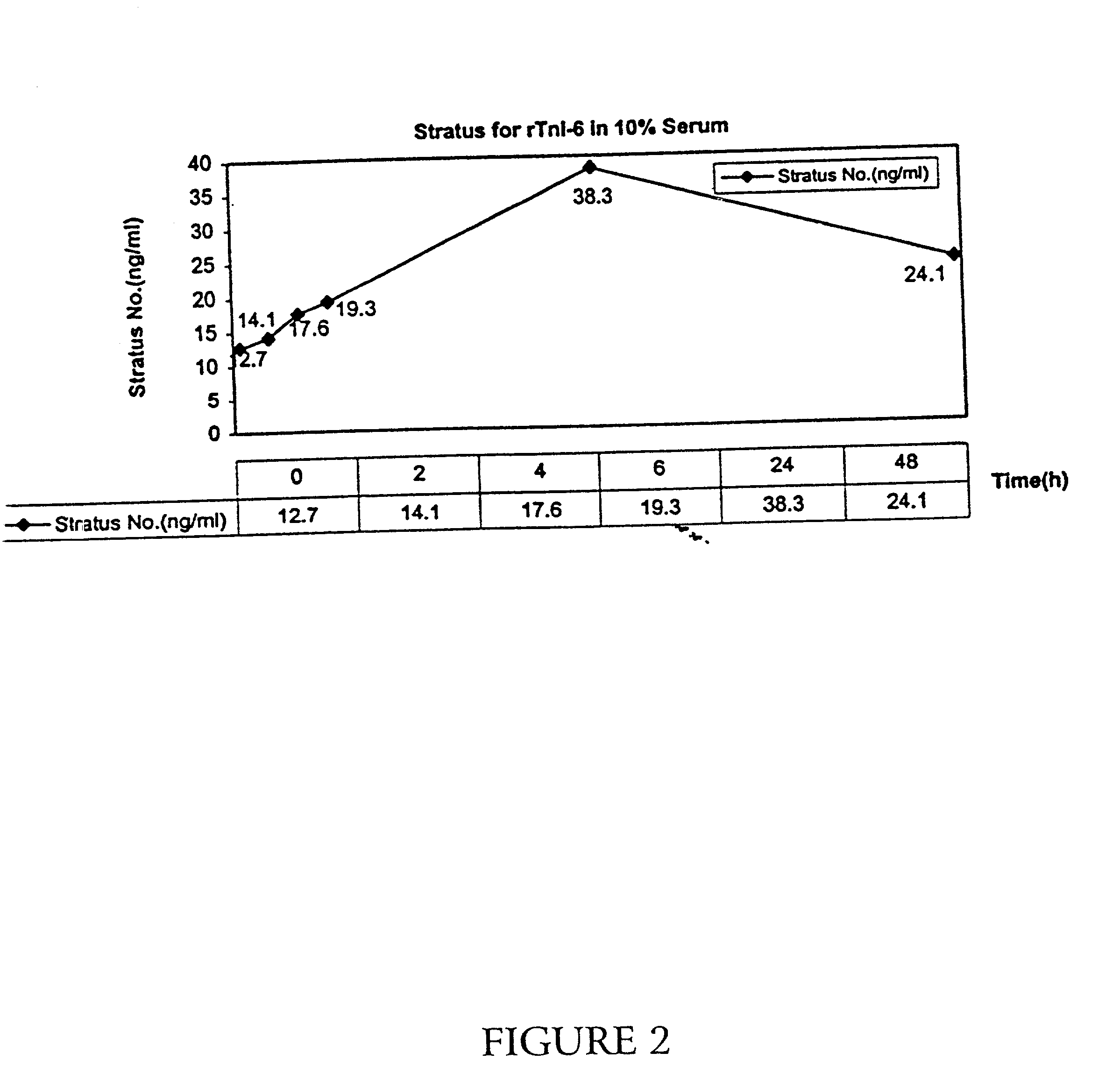Troponin I polypeptide fragments and uses thereof
a polypeptide and fragment technology, applied in the field of troponin i polypeptide fragments, can solve the problems of troponin i in vivo being unstable, unable to be used interchangeably amongcalibrators/controls, and undergoing degradation
- Summary
- Abstract
- Description
- Claims
- Application Information
AI Technical Summary
Problems solved by technology
Method used
Image
Examples
example 1
Preparation of Recombinant Polypeptides Corresponding to Troponin I Fragments
[0042] The cardiac troponin I fragment 1-99 was cloned from the full-length human cardiac troponin I cDNA by polymerase chain reaction using specific primers designed to amplify the TnI 1-99 region. After confirmation by DNA sequencing, the cDNA was then inserted into a pET expression vector. E. coli strain BL21(DE3) was transformed with the resulting construct and the selected clones were grown in LB medium for protein production. Modifications of certain codons were made to facilitate expression, without altering the amino acid sequence. TnI 1-99 was isolated from E. coli cells using an affinity column coupled with TnI antibodies recognizing the 1-99 region.
[0043] The E. coli strain was deposited on Jul. 27, 1998, with the American Type Culture Collection. 10801 University Blvd., Manassas, Va. 20110-2209 and accorded Deposit No. 98824.
example 2
Epitope Mapping of Troponin I Fragments
[0044] The troponin I fragment described in Example I, as well as a recombinant, full-length troponin I molecule, additionally containing six N-terminal amino acids (as described in copending application Ser. No. 08 / 862,613 and Ser. No. 08 / 961858, both incorporated herein by reference), were assayed in the Stratus(R), Access(R), and Opus(R) assays, with the following qualitative results:
1 Stratus(R) Access(R) Opus(R) SEQ ID NO: 2 + - + (N-terminal 99 amino acids) Full-length troponin I plus an + + + additional 6 N-terminal amino acids
[0045] These data demonstrate the differential recognition of the troponin I epitopes by the various assay formats. Each of the assays employ two antibodies, a capture antibody, and a detector antibody. All three assay recognized full-length troponin I. The Stratus(R) and Access(R) assays employ two monoclonal antibodies. The latter recognizes the C-terminal portion of troponin I and thus was unable to detect the f...
example 3
[0046] A recombinant, full-length troponin I molecule, additionally containing six N-terminal amino acids (as described above) was incubated in 10% human serum for 24 hours at room temperature. Samples were taken at 0, 2, 4, 6, 24, and 48 hours, and the level of troponin I was determined by immunoassay by the Access(R) and the Stratus(R) assavs for troponin I.
[0047] As shown in FIG. 1, the level of troponin I detected by the Access(R) assay decreased with time, with only 75% of the initial troponin I level present after 2 hours, and only 40% present after 6 hours. At 24 hours, only 16% was present. As described in above, the Access(R) recognizes the C-terminus of troponin I. As shown in FIG. 2. however, when the Stratus(R) assay (which detects a region near the N-terminus) is used on the same samples, an initial increase in detectable troponin I levels is apparent, with an apparent three-fold increase in levels at the 24-hour point, and the level subsequently falling. Thus, it appea...
PUM
| Property | Measurement | Unit |
|---|---|---|
| pH | aaaaa | aaaaa |
| stability | aaaaa | aaaaa |
| size | aaaaa | aaaaa |
Abstract
Description
Claims
Application Information
 Login to View More
Login to View More - R&D
- Intellectual Property
- Life Sciences
- Materials
- Tech Scout
- Unparalleled Data Quality
- Higher Quality Content
- 60% Fewer Hallucinations
Browse by: Latest US Patents, China's latest patents, Technical Efficacy Thesaurus, Application Domain, Technology Topic, Popular Technical Reports.
© 2025 PatSnap. All rights reserved.Legal|Privacy policy|Modern Slavery Act Transparency Statement|Sitemap|About US| Contact US: help@patsnap.com



